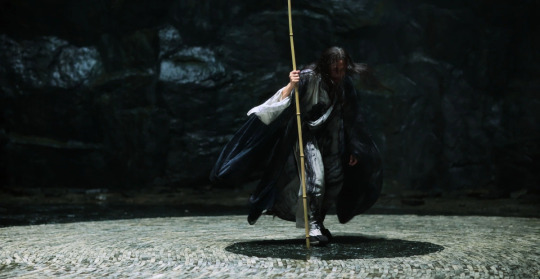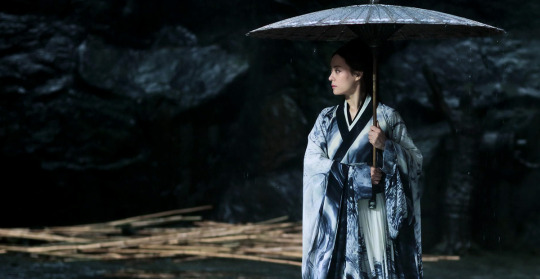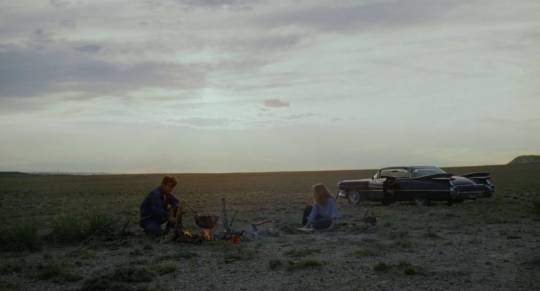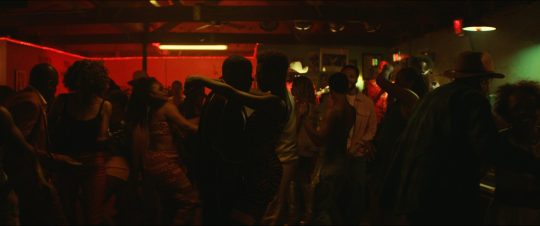Text
QUEEN & SLIM — Q&A
Tras la pandemia causada por el virus COVID-19 hemos sido testigos de los estragos que ha generado otro virus mucho más antiguo y nocivo. Hablamos del racismo y de la muerte de George Floyd en Minneapolis el pasado 25 de Mayo. Hablamos aquí de una obra maestra del cine reciente que no podría estar más de actualidad. Una oda de amor a la raza negra hecha con amor sobre el amor, lo único que podrá salvarnos. #blacklivesmatter.
After the pandemic caused by the virus COVID-19 we’be witnessed the explossion caused by a different virus, one that’s older and more dangerous. We’re talking about George Floyd’s death in Minneapolis the 25th of May. We dive here in a masterpiece of recent cinema that today, could not be more relevant. It’s a poem of love to the black race made with love about love, the only thing that will save us. #blacklivesmatter.
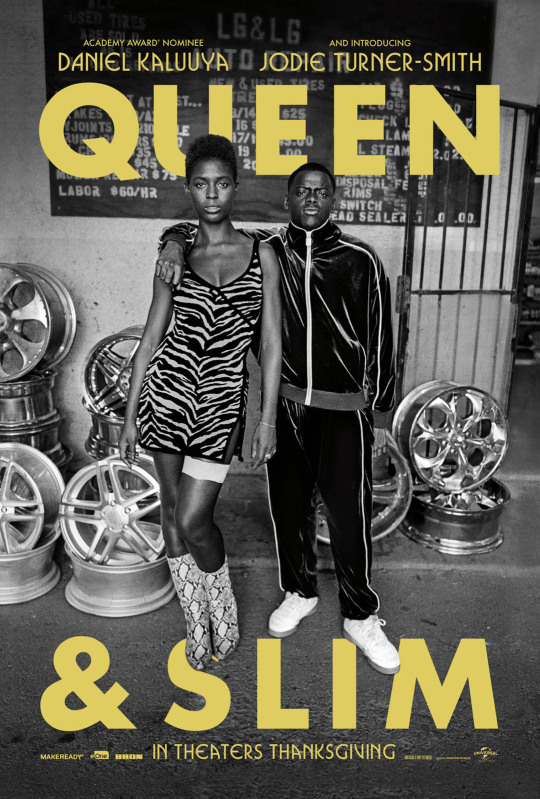
Diego:
En pocas palabras, ¿por qué esta pelicula te ha impactado como lo ha hecho? / In a few words, why has this movie impacted you as it did?
Adrián: Por su naturalidad a la hora de ofrecernos una historia de amor completa en unas circustancias de lo más atípicas. Me sentí atrapado de principio a fin por la química que estos personajes crean entre sí y el viaje que se ven obligados a emprender. Me pareció una visión fresca de un género saturado y un estilo de dirección impecable para una historia que se lo merecía.
It effortlessly offers a complete love story under the most atypical circumstances. I felt traped from the beginning to the end by the character’s chemistry and the journey they’re forced to take. It’s a fresh view in a saturated genre and an impecable direction for a story that deserves it.
D: ¿De todo el apartado técnico, qué destacarias? (Música, guión, interpretaciones...) / Of all the technicals, what would you highlight? (Music, plot, performances...)
A: Destacaría sin duda la dirección de Melina Matsoukas. Siendo su primer largometraje me parece que aprueba sobrada... se nota la influencia de sus anteriores trabajos para publicidad y, sobretodo, con grandes nombres de la música como Beyoncé, Jaz-Z, Snoop Dog o Rihanna entre otros.
Toda la película respira un aire videoclipero que resulta más que atrayente y le da un tono singular a toda la película. Su trabajo de fotografía con Tat Radcliffe, la elección musical junto a Devonte Hynes... A pesar de que el guión tiene alguna laguna argumental está lleno de frases para la posteridad y verdades como puños. Tiene una sensibilidad especial, es evidente que Melina se juntó de gente con talento y les supo transmitir su idea de contar una historia de amor enmarcada en los problemas raciales que sufre la sociedad americana.
I’d highlight Melina Matsoukas’ direction, no doubt. Being her first feature film I think she passes with flying colors... you can tell her past works influenced in publicity and, mostly, working with big names in the music industry like Beyoncé, Jaz-Z, Snoop Dog or Rihanna among others.
The movie has a videoclip theme that’s really appealing and it gives a unique tone. Her cinematography work along Tat Radcliffe, music selection with Devonte Hynes... Despite having a slightly flawless plot it’s full of iconic statements and hard truths. It also has a special sensitivity, it’s obvious that Melina’s joined forces with a very talented crew and she knew how to transmit her ideas behind telling a love story framed under the racial problems that modern american society suffers.
D: ¿Qué hace de “Queen & Slim” una pelicula original y fresca? / What makes "Queen & Slim" an original and fresh movie?
A: Existen muchas road movies, muchas historias de amor inesperado entre dos personas y también muchas películas de denuncia social y racial. “Queen & Slim” es todo esto envuelto en un producto para todos los públicos que habla el lenguaje de la juventud. Es un canto al amor y la revolución que podría calar en la mente de cualquiera y despertar sus ansias de cambio.
There’re many road movies, unexpected love stories between two people and, of course, many films that denounce social and racial issues. “Queen & Slim” is a mixture about these genres wrapped in a product for a wide audience talking the youth language. It’s a call for love and revolution that could plant a seed of change in anyone’s mind.
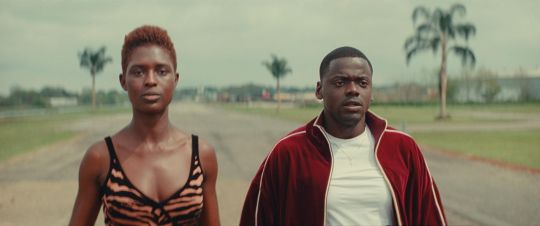
D:
¿Cuál es tu escena favorita? / What is your favorite scene?
A: Probablmenete sea la escena del aeródromo y su conclusión final. Trágica y emotiva. Un broche sensacional para una historia que empezaba a ser increíble y acaba siendo un retrato de la vida misma.
— SPOILER: Después de un viaje orquestado de la forma más conveniente, al final dudamos sobre si realmente esta pareja lograrán escapar. Y de pronto vemos cómo todo llega a su fin y a ellos, en su mirada, aceptar el final más doloroso. Con amor. De la forma más teatral asistimos a un final épico en el que ambos mueren juntos para trascender.
Como en la vida misma, recordamos que muy a menudo la figura de un mártir puede provocar una revolución social sin precedentes. Esperemos que Queen y Slim no queden en el olvido, que viajen de cabeza en cabeza demostrando que juntos somos más, que el amor, en efecto, trasciende. Esperemos que su sacrificio se traduzca en un mundo más justo, mejor.
Probably the airfield scene and its final conclusion. Tragic and emotional. A sensational tie for a story that was becoming incredible and ends up being a portrait of life itself.
— SPOILER: After a trip orchestrated in the most convenient way, finally we doubt whether this couple will really manage to escape. And suddenly we see how everything comes to an end and they, in their eyes, accept the most painful end. With love. In the most theatrical way we witness an epic finale in which both die together to transcend.
As in life itself, we remember that very often the figure of a martyr can provoke an unprecedented social revolution. Let us hope that Queen and Slim are not forgotten, that they travel from head to head showing that together we are more, that love, in fact, transcends. Let us hope that their sacrifice translates into a fairer, better world.
Y concluiré compartiendo un tema del soundtrack que me hará recordar esta película por siempre:
And I’ll conclude by sharing a soundtrack’s theme that will make me remember this movie forever:
youtube
—
Adrián: Los protagonistas ofrecen dos puntos de vista diferenciados sobre la pandemia fotográfica que invade a la sociedad moderna. Todo el mundo tiene una cámara en el bolsillo y puede retratar sus experiencias... Una ve interesante el poder del legado, la prueba de la existencia a través de la imagen. Al otro le basta con permanecer en la memoria de sus seres queridos sin necesidad de dejar ninguna prueba gráfica. En la película vemos ambas opiniones confluir de la forma más romántica, ¿qué opinas tú al respecto? / The protagonists offer two different point of views about the photographic legacy that’s invaded our society. Everyone has a camera in their pocket and the opportunity to portray their experiences... One finds legacy’s power interesting, the proof of your existence through an image. For the other it’s enough to live in his loving one’s memory without any graphic proof. In the movie we see both opinions converge in quite a romantic way, what do you think about it?
Diego: Es una pregunta muy interesante por todas las lecturas e ideas que se agolpan en mi cabeza tras leerla. En mi personalísima opinión, no puedo evitar estar de acuerdo con la opinión de Slim en la película. Por motivos muy personales nunca he tenido una relación estrecha con la fotografía y siempre he sido muy protector de mi intimidad. Esto ha repercutido en mi relación con las redes sociales y también con esta obsesión actual de documentar cada momento. Volviendo a la película, es interesantísimo ver cómo se tocan estos temas en la pequeña conversación que ambos tienen vertiéndose dos opiniones diferenciadas. A continuación, en la misma película y de forma iconográfica, la fotografía de ambos se convierte en un símbolo, algo más que la captura de un momento para el recuerdo, siendo más trascendental y simbólico en pro de su lucha. Queen y Slim pasan a ser símbolo en la sociedad que la película representa. Una vez más, personalmente, no abogo ni siento la necesidad de dejar un legado fotográfico o en imágenes de mi paso por esta vida y sin embargo, entiendo y aprecio la fuerza que ese legado en imagen puede tener según la causa o el peso que se le de sean cuales sean las circunstancias.
It´s a really interesting question that triggers all kinds of ideas in my head while I´m reading it. In my personal opinion, I have toa gree with Slim´s point of view in the film. I´ve personally never had a close relationship with photography and always been really protector of my intimicy. This infleunced my approach to social networks and the nowadays obsession for documenting every moment or experience. Back to the movie, it´s interesting to see how this topics are represented in the movie during their conversation exposing different points of view. Later in the movie and in an ichonographic way, both Queen and Slim picture becomes a symbol, something beyond the capture of a moment as a memory and that becomes trascendental and symbolic supporting their struggle. This makes them become a symbol of the society the movie represents. Once again I personally don´t feel the need to leave a legacy in pictures, however I understand and appreciate how powerful that legacy can be in a picture when the cause worths it.
A: ¿Qué escena elegirías tu favorita? / What scene would be your favourite?
D: Es una pregunta muy difícil ya que la película está llena de escenas increíbles con un poso visual y filosófico potentísimo. Si tuviese que elegir una ahora mismo, habiéndola visionado recientemente y en los tiempos que vivimos, me decantaría por la escena en la que sus protagonistas tienen sexo por primera vez. Ambos se encuentran en un coche en el que sus jadeos y ruta al orgasmo se intercalan con una marcha contra el abuso policial y por la liberación de Queen y Slim. Ellos, inconscientes del gran movimiento que están generando e impulsando en la sociedad, hacen el amor mientras la violencia se desata en las calles. La forma en la que la escena está rodada, musicalizada y montada me dejó boquiabierto. No obstante, la fuerza del film reside en la cantidad de escenas que podría usar para responder a esta pregunta. Simplemente una obra maestra continua.
It´s a hard question because the movie is filled with amazing, visually and philosophically powerfull scenes. If I would get to pick one right now when I´ve watched recenlty in these times we´re living, I would have to pick the one where their main characters are having sex for the first time. They´re both in a car where their moaning and route to te orgasm is mixed with images from a riot against police brutality and freedom to Queen and Slim. In the meantime, they´re oblivious to the huge movement they initiated and pushed in the streets and both make love while violence is firing up the streets. The way the scene is shooted, cutted and the music it has left me amazed. Nevertheless, the strenth of the film lies in the amount of scenes I could use to answer this question making it a continuous masterpiece.
A: ¿Por qué es importante esta película? / Why is this movie so important?
D: Fílmicamente hablando es importante porque es una puta obra maestra, convirtiéndose para mí en una de las mejores películas de 2019. También es vital en los tiempos que corren ya que, incluso sin esa intención directa, “Queen & Slim” no podría estar más de actualidad tras la reciente muerte de George Floyd y la revolución que ha incendiado EEUU y el resto del mundo como consecuencia. No obstante, la película fue rodada en 2019 lejos de los terribles hechos acontecidos en Minneapolis el pasado 25 de Mayo. Está parte de denuncia social que se respira en la película solo nos habla de una terrible realidad que se vive en EEUU y que lleva existiendo desde siempre, afectando diariamente a su población afroamericana, causada por el verdaderamente peligroso virus del racismo. De esta forma, “Queen & Slim” siempre habría sido relevante o importante, aunque su visionado actualmente eleva su simbolismo y trascendencia a un olimpo fílmico de denuncia tan disfrutable como poderoso.
Sticking to cinema, it´s important cause it´s a f*****g masterpiece, becoming to me one of the best movies from 2019. It’s also key in these times because with no intention of being, it became really relevant after the unfortunate death of George Floyd and the revolution that started in EEUU and the rest of the world as a consequence. However, the movie was shot in 2019, far from the events in Minneapolis on the 25th of May. This social and political vibe colours the movie and shows us an awful reality that’s being there forever, affecting daily their afroamercian population and caused by the true dangerous virus, the racism. This being said, “Queen & Slim” would always have been relevant but watching it now raises its symbolism, making it both socially powerfull and really enjoyable.
A: Comenta lo que te parezca sobre el personaje que lleva a Queen y Slim al aeródromo. / Tell us what you think about the character that takes Queen and Slim to the airfield.
D: Aun siendo ajeno personalmente a la cultura afroamericana en los suburbios de cualquier ciudad que se precie en EEUU, a través del cine o del Hip-Hop se puede llegar a tener una idea clara de esta cultura urbana, de sus valores, su forma de vivir, sus luchas... "Queen & Slim” es una explosión artística de la cultura negra en EEUU. Es un film hecho por ellos sobre ellos. Este personaje, como otros en la película, representa una serie de clichés en un personaje tan excéntrico como realista en el marco que nos presenta la película. Con el aspecto de un artista de Hip-Hop, fumando hierba, dientes de oro, llevando un arma consigo y radiando una actitud amigable, tranquila y de aceptación, sin preocupaciones y anclado en el momento. Personaje interesante a pesar de su corto recorrido. Un icono de esta cultura que envuelve a la película y con la que personalmente tanto conecto.
While being strangers to the afroamerican culture in the suburbs of any major city in the USA, through movies or Hip Hop music, one can relate to the idea of this urban culture, its values, way of living, their struggles. ¨Queen & Slim” is an arthistic explossion of the back culture in the USA. It’s a film made by them about them. This specific character, amongst others in the movie, represents a bunch of “cliches” being as eccentric as real in the frame the movie is settled. With the look of a Hip Hop artist, smoking weed, golden teeth, carrying a weapon with him and a friendly, chilled and accepting atittude, no worries and immerse in the present moment. A really interesting character, depite its short appearance. A true icon of this culture present in the movie, to which I strongly connect.
youtube
0 notes
Text
SUNNY VIBES — List
Películas bajo el Sol como antesala de lo que se nos acerca. Vacaciones y amores, playas y cuentos de hadas, folclore, tradición y algún que otro misterio es lo que encontrarás en esta lista. Todo bajo el calor, ¡prepárate para el verano!
Movies under the Sun as a prelude to what is coming. Holidays and love, beaches and fairy tales, folklore, tradition and odd mysteries is what you will find in this list. Everything under the sunlight, get ready for summer!
youtube
Call Me by Your Name (2017) — Luca Guadagnino
Diego: La historia de amor de Elio y Oliver respira verano. Este film podría estar fácilmente en numerosas listas por varios motivos ya que, a pesar de ser un tema tratado en cine anteriormente, respira originalidad y frescura a través de todo su metraje. En ocasiones, no es tan importante qué se hace, sino cómo se hace. En ¨Call me by your name¨ Luca Guadagnino hace alarde de una mano artesana sublime. En su metraje, hay perfección en cada plano, escena, silencio o mirada. Su dirección, junto con el alarde interpretativo y química entre Timothée Chalamet y Armie Hammer, nos deja ser espías de un amor veraniego como pocas veces vimos antes. Hay electricidad en pantalla y la sentimos asi como sentimos lo prohibido y el atractivo de probarlo. De extrema sensibilidad, merece estar en esta lista por sus planos constantes de naturaleza y quietud bajo el sol de un pueblo italiano, su río, sus baños al atardecer, su escasez de vestuario… En fín, película veraniega con una historia que traspasa la pantalla, sientes como tuya y se queda en ti para siempre. Elio y Oliver existen en el imaginario colectivo y siempre se quedarán en ese verano eterno en Italia…
Elio and Oliver’s love story breathes summer. This film could easily be in different lists for various reasons because even being a famous topic touched in movies before, it’s freshly approached along the whole film. Sometimes, it’s not that relevant what’s done but how it’s done. In “Call me by your name” Luca Guadagnino shows off his sublime artisan hand. In his film, there’s perfection in every shot, scene, silence or gaze. His directing together with the amazing performance and chemistry between Timothée Chalamet and Armie Hammer, allow us to be spys and voyeurs of a summer love sotry we barely seen before. There’s electricity in the screen we feel as we feel the forbidden and the rush of testing it. Of extreme sensibility, this film worths being in this list for its amazing and constant shots of nature and stillness under the sun of a small italian village, its river, their baths, the lack of clothes… Anyways, a summery movie with a story that pierces the screen, makes you feel it like your own and remains with you forever. Elio and Oliver exist in the collective imaginary construct and they will always stay in that everlasting summer in Italy...

The Beach (2000) — Danny Boyle
D: ¨The Beach¨ es uno de esos casos de película maltratada en su momento por la crítica y público por motivos ajenos a la calidad de la misma.. El excelente Danny Boyle venía de haber cambiado el cine británico con ¨Trainspotting¨ y su incursión en Hollywood con el rostro de Leonardo DiCaprio acaparando su cartel cosechó todas las expectativas posibles y, una vez más, Danny Boyle hizo lo que quiso con su adaptación de la novela de Alex Garland. De esta forma, viajamos con Richard, el personaje de DiCaprio, a Tailandia, donde en busca de aventuras, acaba sabiendo de una paradisiaca isla, apenas tocada por turistas donde un grupo de viajeros han establecido una especie de utopía hippy que rápidamente atrapa al personaje de DiCaprio. Aquí, Boyle nos regala una disección de esta utopía y las dos caras de la misma a la par que del ser humano. Muy interesante ver como el paraíso se puede convertir en el infierno, motivado por la complejidad del ser humano y todo lo que compone nuestra psique. Las tremendas actuaciones, giros de guión, la música de Moby y sus parajes nos envuelven y trasladan a este paraíso soleado, donde querríamos quedarnos para siempre… al menos durante la primera mitad de la película.
“The Beach” is one of those cases of a movie beaten up by the press and the public when it was released for reasons beyond its quality. The excellent Danny Boyle was coming from changing british cinema with “Trainspotting” and his incursion in Hollywood with Leonardo DiCaprio’s face taking over the poster created all possible expectations and once again, Danny Boyle did what he wanted with the adaptation of Alex Garland’s novel. This way, we travel with Richard, the character played by DiCaprio to Thailand looking for adventures, where he ends up hearing of a heavenly island, barely touched by tourists where a group of travellers established a hippy utopia that quickly haunts DiCaprio’s character. Here, Boyle delivers a dissection of this heaven and its two faces as well as the complexities of the human mind. It’s really interesting to see how this paradise can easily turn into hell, motivated by human nature. The great performances, plot twists, Moby’s music and its beautiful settings involve us and take us to this sunny paradise where we would stay forever… or at least during the first half of the movie.
youtube
Spring (2014) — Justin Benson & Aaron Moorhead
D: Justin Benson and Aaron Moorhead son dos directores estadounidenses que tienen una clara pasión por el cine de terror o de corte fantástico. Su trabajo ha sido por el momento muy interesante con ¨Spring¨ siendo hasta el momento su mejor obra . ¨Spring¨ es soleada y tiene un aura veraniega en gran parte debido a que transcurre principalmente en un pueblo italiano, donde Evan, un joven norteamericano, viaja para aclarar su mente. Allí acabará conociendo una chica, Louise que es mucho más interesante de lo que parece en un principio. ¨Spring¨ es tan fantástica como original. No creo haber visto nunca película igual y por este motivo, entre otros, siempre ha tenido un lugar especial en mi memoria. Merecería estar en diversas listas por su mezcla de géneros tan bien equilibrada. No obstante, su mejor cualidad es su inteligente guión y lo bien dibujados que están sus personajes. Las situaciones que vive Evan al llegar a Italia y la facilidad para empatizar con él, su viaje y sus emociones son lo que nos hace quedarnos y seguirle, su historia de amor la que nos emociona y su originalidad narrativa y mezcla de géneros la que la hace difícil de olvidar.
Justin Benson and Aaron Moorhead are two american movie directors with a clear inclination and passion towards horror and fantastic genres. Their works had been really interesting so far, with “Spring” being their best work yet. “Spring” is really sunny and has a summery vibe all the way caused mainly by its setting, taking place in an italian village where Evan, a northamerican young man, travels to clear his mind and will end up meeting an attractive woman, Louise, who’s much more interesting than it seems at first. “Spring” is as fantastic as original. I don’t think I’ve ever watched such a movie like this one and for this reason, among others, it always had a special place in my memory. It would be worthed it being in numerous lists for its mix of really well balanced genres. Nevertheless, its best quality is its intelligent script and how well portrayed their characters are. The situations lived by Evan in the movie when he gets to Italy and the easiness to empathize with him, his trips and his emotions are what makes us stay and follow him through the movie. His love story is what move us and its original narrative and mix of genres what makes it difficult to forget.
—

The Fall (2006) — Tarsem Singh
Adrián: Esta joya de producción India fue dirigida por Tarsem Singh durante 4 años y en 28 países diferentes. Es una historia épica llena de fantasía que me habría encantado escuchar siendo niño, aunque en eso me convertí cuando la vi por primera vez. Destacaría las interpretaciones de Lee Pace y Catinca Untaru, los dos protagonistas, quienes consiguen darle una intriga increíble a la película. Pero no puedo dejar de hablar de los paisajes... La ambientación y fotografía, dominada por escenas bajo el sol abrasador de Oriente Medio, muestran un espectáculo audiovisual a la altura de lo exótico de la cinta. Una espectacular y entretenida película que hará las delicias de nuestro niño interior, que nos hará viajar a los confines de nuestra imaginación.
This Indian production is a hidden jewel directed by Tarsem Singh for 4 years and in 28 different countries. It is an epic story full of fantasy that I would have loved hearing as a child, and yet that's what I became when I first saw it. I would highlight Lee Pace and Catinca Untaru’s acting, the two protagonists, who manage to give an incredible intrigue to the film. But I must talk about the landscapes... The setting and cinematography, dominated by scenes under the scorching sun of the Middle East, present us an audiovisual spectacle at the height of the film’s exoticness. A truly entertaining film that will delight our inner child, that will make us travel to the limits of our imagination.
youtube
Le Mépris (1963) — Jean-Luc Godard
A: “Le Mépris” nos muestra la grieta que se abre en la relación de una pareja, somos testigos de las terribles consecuencias que tiene el más simple arañazo si no es reparado y esto nos ayuda a entender lo importante que es la comunicación sincera.
Godard conjuga esta historia con metacine, pues todo gira en torno al encargo que recibe Paul Javal (Michel Piccoli) para participar en la próxima película del director alemán Fritz Lang (que se interpreta a sí mismo). Aquí entran en juego las sunny vibes: el set de rodaje se ubica en la isla italiana Capri, un entorno idílico del Mar Mediterráneo con un clima soleado perfecto. Asistimos a este fatal malentendido como un miembro más del equipo de producción gracias a la dirección de Godard, que nos muestra un paraje de lo más veraniego.
Es difícil olvidar la magistral banda sonora de Georges Delerue, la belleza del entorno, la sensual y dolida mirada de Camille (Brigitte Bardot) o los paseos de Paul bajo el sol.
"Le Mépris" shows us the crack that opens in the relationship of a couple, we witness the terrible consequences of the simplest scratch if it’s not repaired, helping us to understand how important sincere communication is.
Godard combines this story with metacinema, since everything revolves around the commission that Paul Javal (Michel Piccoli) receives to participate in the next film by the german director Fritz Lang (who plays himself). Here the sunny vibes come into play: the film’s location is the italian island of Capri, an idyllic setting in the Mediterranean Sea with perfect sunny weather. We attended this fatal misunderstanding as one more member of the production team thanks to the direction of Godard, who shows us a most summery setting.
It is difficult to forget the masterful soundtrack of Georges Delerue, the beauty of the surroundings, the sensual and hurt gaze of Camille (Brigitte Bardot) or Paul's walks under the sun.
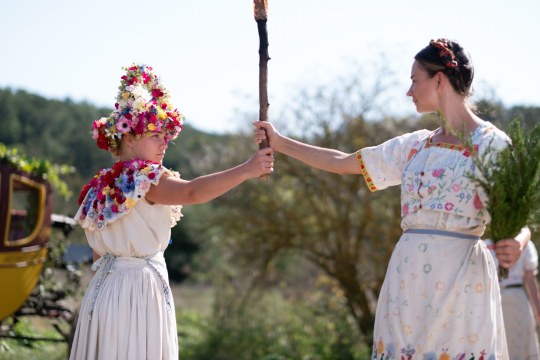
Midsommar (2019) — Ari Aster
A: A pesar de quitarnos las ganas de un festival europeo folclórico a medida que el metraje avanza, Ari Aster logra ambientar su película bajo un sol persistente. Por todos es bien conocido que la oscuridad es un elemento a tener muy en cuenta en el género de terror, y aun sin serlo es un recurso muy utilizado para provocar sensaciones de angustia, miedo o incertidumbre. En “Midsommar” no es así, en esta película sentimos todo y más sin necesidad de perdernos detalles por falta de luz. En este ambiente veraniego y de apariencia calmada no nos perderemos ni un solo detalle, incluso se nos auguran acontecimientos antes de verlos en pantalla. La puesta en escena de Aster es magistral en este aspecto, dándonos a conocer los entresijos de su película y haciendo evidente lo que puede suceder nos retorcemos en la butaca.
Gran terror psicológico, no apto para estómagos sensibles, que nos hará viajar a una remota aldea de Suecia durante el solsticio de verano.
Despite taking away the desire for a European folk festival as the movie goes on, Ari Aster manages to set his film in the lingering sun. It is well known that darkness is an element to be taken into account in the horror genre, even in any other genre it is a widely used resource to provoke feelings of anguish, fear or uncertainty. In “Midsommar” it’s not like that, in this film we feel everything and more without missing details due to lack of light. In this summery and calm-looking environment we won’t miss a single detail, events are predicted before we see them on screen. The staging of Aster is masterful in this regard, making us aware of the ins and outs of his film and making evident what can happen, we writhe in our seat.
Great psychological terror, not suitable for sensitive stomachs, that will make us travel to a remote village in Sweden during the summer solstice.
youtube
Pájaros de verano (2018) — Ciro Guerra & Cristina Gallego
A: Incursión en la cultura colombiana de producción sublime. “Pájaros de verano” es una película que puede tener varias lecturas. Ambientada en los años 70′ muestra el inicio del narcotráfico y cómo una familia indígena del desierto de Guajira hace frente a esta situación. Con la creciente demanda de droga el dinero llega a una familia que se enfrenta por primera vez a la ambición de poder desmedida que los billetes encienden en las personas. Una lectura sobre el orígen del desarrollo moderno y su impacto en las culturas antiguas.
Con una fotografía espectacular y un ritmo pausado, contenido, me recuerda a un Nicolas Winding Refn que intercambia los neones y estilo pop por la crudeza de la tradición. Es tan lenta y violenta como soleada, así que pónganse mucha crema.
Sublime production as an incursion into the colombian culture. "Pájaros de verano" is a film that can have several readings. Set in the 70s, it shows the beginning of drug trafficking and how an indigenous family from the Guajira desert copes with this situation. With the growing demand for drugs, the money reaches a family that is facing for the first time the ambition of excessive power that bills ignite in people. A reading on the origin of modern development and its impact on ancient cultures.
With a spectacular cinematography and a contained rhythm, it reminds me of a Nicolas Winding Refn exchanging neon and pop style for the harshness of the tradition. It is as slow and violent as it is sunny, so have plenty sunscreen.
3 notes
·
View notes
Text
INTO DARTH MAUL’s UNKNOWN STORY — In depth
A continuación resumiremos toda la historia de Darth Maul, un villano sucumbido por el odio y evocado siempre a la frustración y derrota. Comantaremos muchos detalles sobre el universo expandido de Star Wars, practicamente toda la información está recogida en la película “Star Wars. Episode I: The Phantom Menace” y, sobretodo, las series animadas “Star Wars: The Clone Wars” y “Star Wars Rebels”, las cuales animo a ver a todo fan de este universo. Advertimos de que este post recoge grandes SPOILERS sobre la historia del personaje y la saga. Disfrútenlo:
Below we will summarize Darth Maul’s entire story, a villain succumbed to hatred and always evoked to frustration and defeat. We will comment on many details about the Star Wars’ expanded universe and the information collected in the movie "Star Wars. Episode I: The Phantom Menace” but, most of all, the animated series “Star Wars: The Clone Wars” and “Star Wars Rebels”, which I encourage every fan of this universe to watch. We warn that this post collects major SPOILERS about the character’s story and the saga. Enjoy!:

Darth Maul se nos presenta por primera vez como aprendiz de Darth Sidious en “Star Wars. Episode I: The Phantom Menace” (1995), donde su aparición es corta pero intensa. Antes de continuar indagando sobre este personaje creo que es importante establecer de dónde viene y cuál es su pasado:
Maul es un zabrak procedente de Dathomir, planeta rico en energías oscuras reinado por el clan de las Night Sisters. Sidious sería el encargado de tomar a Maul a edad muy temprana, separándolo a la fuerza de su clan para entrenarle en el lado oscuro de la fuerza y convertirlo en su primer aprendiz. Como se puede esperar de un Lord tenebroso, Sidious es vilmente egoísta y su plan de dominación no entiende de compasiones. En Maul buscaba un diamante en bruto, un joven al que pulir y dar forma a su gusto. Tras un largo entrenamiento se enfrentaría por segunda vez a un jedi, en Naboo, para encontrar su derrota a manos de Kenobi. Maul es dado por muerto y reemplazado por el Conde Dooku.
Darth Maul is presented to us for the first time as Darth Sidious’s apprentice in “Star Wars. Episode I: The Phantom Menace” (1995), where his appearance is short yet very intense. Before continuing dissecting this character I believe is important to set where he’s coming from and his past:
Maul is a “zabrak” from Dathomir, a planet rich in dark energies governed by the Night Sisters’s clan. Sidious was the one taking fiercely Maul by his side at an early age, separating him from his tribe to train him into the dark side of the force and transform him into his first apprentice. As it may be expected from a Dark Lord, Sidious is really selfish and his domination plan doesn’t understand compassion. He was looking for an uncut diamond, a young one to grind and shape to his liking. After a long training, he would face for the second time a jedi, in Naboo, to be defeated by Kenobi. Maul is then considered dead and replaced by Count Dooku.
youtube
—

Lejos de ser su final, el odio y rencor hacia Obi-Wan le mantuvo con vida, logrando descender por el pozo del reactor y eventualmente llegar a un contenedor de basura. Su cuerpo destruido fue soltado en un vertedero de Lotho Menor, el planeta en cuyas entrañas viviría la siguiente década convertido en ciborg renegado y sucumbiendo a la locura.
Sería durante las Guerras Clon cuando Maul es rescatado y rehabilitado por su hermano de sangre Savage Opress. Consumido por la ira hacia los jedi, y en concreto hacia Obi-Wan, ambos emprenden una cacería en busca de venganza, lo que les uniría a la Death Watch, un grupo terrorista mandaloriano rechazado por el gobierno de su planeta.
Far from being his annihilation, the resentment and hate towards Obi-Wan kept him alive, surviving his fall down the reactor well and eventually ending up in a garbage container. His destroyed body was dropped in a dump in Lotho Menor, a planet where he would be isolated for the next decade transformed into a renegade cyborg driving mad.
It would be during the Clone Wars when Maul is rescued and rehabilitated by his brother Savage Opress. Consumed by his anger towards the jedi, particularly Obi-Wan, they will start a haunt for revenge, what would make them join the Death Watch, a mandalorian terrorist group rejected by their planet’s government.

—
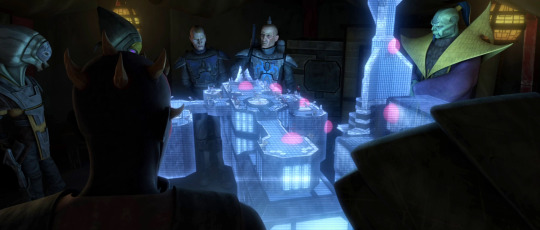
De la unión entre Death Watch y el tándem Maul/Savage surgiría The Shadow Collective, una alianza criminal compuesta además por Mother Talzin (Madre, líder y guía espiritual de las Night Sisters) y posteriormente por Black Sun, el Pyke Syndicate, Hutt Clan y los Night Brothers. Su objetivo principal sería derrotar a la Confederación de Sistemas Independientes, la República Galáctica y materializar la venganza personal de Maul contra Darth Sidious por haberle usado como peón en su plan y darle por muerto en Naboo.
Durante el transcurso de las Guerras Clon Maul consigue enfrentarse a Kenobi en varias ocasiones, sumando tensión a la relación de venganza que ambos mantienen. La alianza con Death Watch le permite revelarse contra el gobierno del planeta Mandalore y tomar el control del mismo gracias al asesinato a sangre fría de Satine Kryze, líder de los mandalorianos. Esto supone una gran cicatriz en Obi-Wan al ser testigo del crimen contra la mujer con la que mantenían una relación de amistad y sentimientos de afección muy profundos.
From the link between Death Watch and Maul/Savage, The Shadow Collective was born, a criminal alliance joined as well by Mother Talzin (Mother, leader and spiritual guide from the Night Sisters) and afterwards by Black Sun, the Pyke Syndicate, Hutt Clan and the Night Brothers. Their main goal would be to defeat the Independent Confederate System, The Galactic Republic and materialize Maul’s personal revenge against Darth Sidious for being used in his plan and being left to die in Naboo.
While the Clone Wars were taking place, Maul finally fights Kenobi in several occasions, feeding their mutual hatred exponentially. The alliance with Death Watch allows him to rise up against the Mandalore planet’s government and take control thanks to the assassination of Satine Kryze, the leader from the mandalorians. This creates a scar in Obi-Wan when he witnesses the crime against a woman he was really close to and started to have feelings for her.
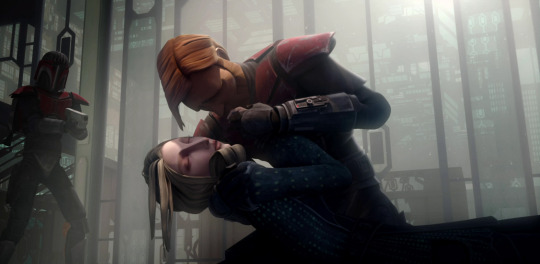
—
youtube
Este evento sitúa a Maul como líder de Mandalore por un tiempo muy breve, pues todo llega a los oídos de Darth Sidious, quien decide ponerle fin personalmente. Tras una intensa batalla en la que vemos el verdadero poder del Lord tenebroso, Savage Opress pierde la vida y Maul termina preso para acabar siendo torturado por su nuevo aprendiz Dooku, con la intención de extraer información sobre los planes del Shadow Collective. Ellos mismos conseguirían rescatarle para poder culminar su rebelión contra el gobierno de Mandalore y recuperar el control del mismo. Sería durante esta etapa cuando la conexión de Maul con la fuerza le otorga visiones sobre el ascenso de Darth Sidious y la perturbación en la Fuerza que Anakin está provocando, acercándose cada vez más al lado oscuro. Con la intención de parar sus pies The Shadow Collective elabora una trampa encubierta por un nuevo asalto al planeta Mandalore, tratando de atraer a Skywalker y matarlo. Todo se trunca de la forma más épica cuando Ahsoka Tano responde a la llamada como renegada de la Orden Jedi, deteniendo el asalto y al propio Maul. Ambos tantearían la idea de unirse en fuerzas cuando éste le confiesa a Ahsoka sus visiones y el peligro inminente. No obstante, y fiel a su sentido de la justicia, la antigua aprendiz de Anakin captura a Maul para que sea enjuiciado por el Consejo Jedi.
Las Guerras Clon llegarían a su fin poco después con la ejecución de la Orden 66, dejando en la estacada a los Jedi, forzando a sus supervivientes al exilio y permitiendo la huída de Maul.
These events place Maul as the leader from Mandalore for a short period of time as everything gets to Darth Sidious attention, who decides to finish it personally. After a really intense battle where we witnessed Lord Sidious’s true power, Savage Opress dies and Maul ends up prisoner and tortured by his new apprentice Dooku in exchange of some information about the Shadow Collective plans. The Shadow Collective would end up rescuing him to conclude their rebellion against the Mandalore government and get back its control. It’s during these times when Maul’s connection with the force give him visions of the rise of Darth Sidious and the disturbance Anakin is creating in the force as he gets closer to the Dark side. With the intention to stop him, the Shadow Collective elaborates a trap covered by a new assault to Mandalore’s planet, trying to attract Skywalker to kill him. Everything fails when Jedi´s renegade Ashoka Tano stops both the assault and Maul himself. Both would be tempted with the idea of joining forces when Maul shares with her his visions about the imminent threat. Nevertheless, faithful to her sense of justice, old Anakin’s apprentice captures Maul to be judged by the Jedi Order. The Clone Wars would get to the end shortly after the execution of the Order 66, striking Jedis, forcing their survivors to exile while allowing Maul’s escape.
youtube
—
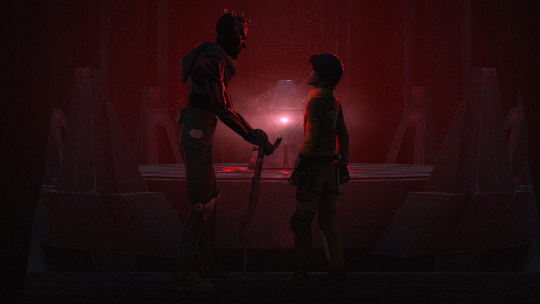
Años más tarde, ya con el Imperio establecido como dominador de la Galaxia y los Jedi en el completo exilio, Maul hace su regreso al encontrarse con Ezra Bridger, jóven revolucionario y aspirante a Jedi. En su búsqueda de los Holocrones Sith recibe la ayuda de Maul, quien le ofrece conocimiento acerca de los caminos de la Fuerza. De este primer encuentro entre ambos, la primera aproximación de Bridger al lado oscuro de la Fuerza, resulta un nuevo choque entre Ahsoka y su antiguo enemigo, ayudado esta vez por el maestro exiliado de Ezra, Kanan Jarrus.
Finalmente, y gracias al poder de los Holocrones Sith, Maul acaba consiguiendo las respuestas que busca y su ansiado reencuentro con Obi-Wan Kenobi al desvelarse su paradero: un planeta desértico con dos soles, Tatooine. Tras resolverse el puzzle presenciamos la última batalla de Maul, quien es vencido rápidamente por un envejecido Kenobi. En esta último choque presenciamos el ascenso de Obi-Wan en el uso de la fuerza, un encuentro de lo más legendario en el que Maul descubre el motivo del paradero de Kenobi: custodiar al elegido, el que logrará derrotar al lado oscuro, el hijo perdido de Padmé y Anaki, Luke Skywalker.
Years later with the Empire established as owner of the Galaxy and the Jedi in complete exile, Maul makes his return when finding Ezra Bridger, a young rebel and Jedi aspirant. In his search for the Sith’s Holocrones, Maul offers him knowledge about the ways of the Force. From this first meeting being Ezra´s first contact with the Dark side, a new battle between Ashoka and Maul rises, joined this time by Ezra’s master, Kanan Jarrus.
Finally and thanks to the Sith Holocrone’s power, Maul ends up getting the answers he was looking for and his desired reunion with Obi-Wan Kenobi when he gets to know his location: a dessert planet with two suns, Tatooine. After the puzzle is unfolded, we witness Maul’s last battle, who’s defeated quickly by an old Kenobi. During this last battle, we witness Obi-Wan rise in the force, a legendary encounter where Maul discovers the reason for Obi-Wan exile, the custody of the chosen one, the one who will defeat the Dark side, the last son of Padme and Anakin, Luke Skywalker.
youtube
Tras una vida llena de odio y dolor Maul acaba muriendo en manos de su más respetado rival. Tras su caída ambos aprenden que el enemigo común es Darth Sidious y es él en quien se culminará su venganza. No podemos más que compadecernos y admirar la templanza de Ben Kenobi, quien le ofrece un atisbo de esperanza mientras muere en sus brazos.
After a life full of hate and pain, Maul ends up being killed by his most respected enemy. After their battle, both learn their common enemy has always been Darth Sidious and it’s him who will culminate his revenge. We can only sympathize and admire the peace within Ben Kenobi, who offers Maul a glimpse of hope while dying into his arms.
0 notes
Video
youtube
Nan Fang Che Zhan De Ju Hui (2019) — Diao Yinan
0 notes
Text
VILLAINS — List
Todos llevamos el mal dentro, cómo podríamos elegir el bien sin conocerlo... Como fuente de inspiración aquí van aquellos personajes que se perdieron en el camino y se quedaron en nuestra memoria.
We all carry evil within so how could we do good when not knowing evil... As inspiration, here we have those characters who lost their way and remained in our memory.
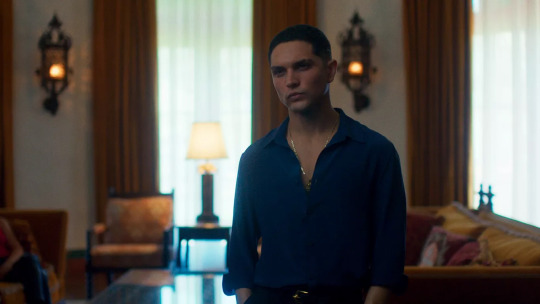
Jesus / Too Old to Die Young (2019) — Ed Brubaker & Nicolas Winding Refn
Diego: La serie de Nicholas Winding Refn “Too Old to Die Young” supuso una de las mejores sorpresas fílmicas de 2019 y ha dejado gran poso en mi memoria cinematográfica. Somos grandes amantes del personalísimo estilo tanto visual como narrativo de Winding Refn y en esta serie da rienda suelta a todas sus manías creando una serie oscura y de corte neo-noir, sublime en su belleza visual. Uno de los principales culpables de mi obsesión es Jesus Rojas. En “Too Old to Die Young” la línea entre héroe y villano es casi inexistente pero el personaje complejísimo de Jesus, interpretado por Augusto Aguilera, es maldad pura llena de matices. Su personaje es atractivo física y mentalmente y, en conjunto con el estilo de la serie, sus apariciones en pantalla se vuelven hipnóticas y adictivas. Sus escenas son probablemente las mas viscerales del conjunto, las que siempre quedarán en mi memoria. Y sus ojos, ansiosos de extrema venganza, traspasaron en todo momento la pantalla creando todo tipo de sensaciones en el espectador.
Nicholas Winding Refn’s TV show “Too Old to Die Young” became one of the most satisfying cinematographic experiences from 2019 and guaranteed an everlasting place in my memory. We are true lovers of Winding Refn’s own personal, visual and narrative style and in his TV show, he was granted complete freedom and he meant it, creating a really dark, neo-noir show of sublime visual beauty. One of the reasons for my obsession was Jesus Rojas. In “Too Old to Die Young” the line between hero and villain is really thin yet the really complex character of Jesus Rojas, amazingly portrayed by Augusto Aguilera, is pure evil full of different nuances. His character is really attractive both physically and mentally and together with the TV show’s style, his moments on screen turn into hypnotic and addictive. Are those scenes, probably the most visceral ones, the ones that will always remain in my memory and his eyes, thirsty of extreme revenge would pierce the screen creating all kinds of sensations in the viewer.

Scar / The Lion King (1994) — Rob Minkoff & Roger Allers
D: Es obvio que los villanos de las películas de Disney nos han marcado a todos de una forma u otra, especialmente a la generación de los 90′. Fueron para muchos nuestro primer contacto con la maldad y su abanico de emociones: celos, envidias, ira, injusticia… Personalmente, Scar me marcó de una forma especial al enfrentarme a “El Rey León” con 4 años y ver repetidamente esta película. Scar es el villano puro. Normalmente en Disney somos testigos de la maldad mezclada con sentido del humor o sentimos incluso empatía hacia esos villanos castigados por la vida de una forma u otra. No es el caso de Scar. En él vemos una representación infantil del Claudio de “Hamlet”. La envidia a su hermano, heredero del trono, lo lleva a su asesinato antes los ojos de Simba. Este es el comienzo de un camino de lecciones para el pequeño y los espectadores, entre ellos, niños que entendieron que la vida no es justa y que a veces debemos sortear estos obstáculos para encontrarnos a nosotros mismos. Y “Hakuna Matata”... Villano, traidor, asesino y totalmente necesario. Scar es la antítesis de un Simba que, en su camino del héroe, le debe todo a Scar.
It’s quite obvious that Disney’s villains left a heavy stamp in all of us, especially in the 90’s generation. For most of us, they were our first contact with evil and all its emotions: jealousy, anger, injustice… Personally, Scar impacted me strongly when facing “The Lion King” being 4 years old and watching it over and over again. Scar is pure evil. Normally in Disney, we witness evil sprinkled with sense of humor or we even empathize with these villains who’re punished by life in one way or another. This is not Scar’s case. In him, we see an infantile take of Claudio from “Hamlet”. The envy towards his brother, heir to the throne, leads him to his killing witnessed by Simba. This is the beginning of his journey, fulfilled with lessons for him and for the viewers, all those kids who learned life is not fair and sometimes, we need to overcome the obstacles to find our true selves and… Hakuna Matata. Villain, traitor, killer and totally necessary. Scar is Simba’s antithesis whose hero's journey, owes everything to Scar.

Josef / Creep (2014) — Patrick Brice
D: El found footage encuentra en “Creep” un soplo de aire fresco en este estilo de películas que parecían estar agotando el formato que “La bruja de Blair” llevó a la cúspide en 1999. En “Creep”, Aaron es un videógrafo contratado para un trabajo de un solo día en un paraje inhóspito por Josef, un hombre enfermo terminal que tiene la intención de dejar unas memorias grabadas. Josef, interpretado por Mark Duplass (que también escribe el guión de la película) es el caramelo que convierte a “Creep” en una dulce pesadilla. El personaje, lleno de matices y de un sentido del humor y comportamientos bizarrísimos nos va dejando ver y comprender sus intenciones reales a través del metraje. Descubrimos todo al mismo ritmo que Aaron, que poco a poco y compartiendo su tiempo con el excéntrico Josef, intenta averiguar qué hay detrás de toda su historia. Son los comportamientos de Josef y su excentricidad, salpicada con momentos hilarantes, la que nos pone los pelos de punta y hace sentir incómodos. Esto cocina una tensión a fuego lento que culmina con un final muy turbio que dejará gran poso en nosotros a medida que vemos avanzar los créditos finales, atónitos por lo que acabamos de presenciar.
“Found footage” finds in “Creep” a blow of fresh air for this kind of movies who seemed to be draining since "Which Blair Project" started it back in 1999. In "Creep", Aaron, a young videographer is hired for a one-day job in a remote mountain by Josef, a dying man who wants to leave some memories and messages behind. Josef, portrayed by Mark Duplass (who also writes the script) is the candy that makes of “Creep” a sweet nightmare. The character and his numerous nuances shows a strange sense of humor and really odd behaviors, unfolding slowly his true intentions along the way. We get the information at Aaron’s rhythm, who by sharing his time with the eccentric Josef, gets to know what’s behind the story. Are these behaviors and eccentricity from Josef, sprinkled with hilarious moments, what gives us goosebumps and makes us feel uncomfortable. This slow cooked tension is leading us to a creepy finale which will leave a heavy stamp in the viewers while the end credits are rolling, recovering from what we just witnessed.
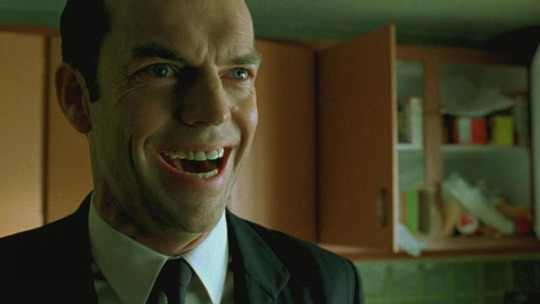
Agent Smith / Matrix Trilogy — Lilly Wachowski & Lana Wachowski
D: “Matrix” supuso un antes y un después en la historia del cine y probablemente también en como me enfrenté al mismo. En esta película tenemos un ying y yang perfectamente definidos, un héroe y villano, una antítesis perfecta entre Neo, el elegido, y el Agente Smith. Este último comienza como agente del sistema Matrix y acaba siendo un programa exiliado que se manifiesta como un virus infórmatico. Su programación sirve para vigilar Matrix y eliminar amenazas potenciales al sistema. Su rol es contrario al de Neo, al igual que lo que ambos personifican en la historia. Smith es un espléndido villano que, amparado en su naturaleza poco humana, ofrece un escaso abanico de emociones. Es eficiente y hombre con una sola misión, que sigue a pesar de todo y de la forma que sea. Altamente inteligente, frio y calculador, con toques humorísticos a lo largo de la trilogía, numerosos pensamientos y discursos filosóficos a la par que poco humanos. Una vez mas, Smith da razón de ser a Neo y viceversa.
“The Matrix” marked an before and an after at film history and probably also in how I faced film from that moment on. In this movie we have a clear differentiate ying and yang, a hero and a villain, the perfect antithesis between Neo, the chosen one and Agent Smith. Smith is an agent from the system “The Matrix” who will become an exile program that manifests himself as a virus. His role and programming are to police and maintain The Matrix by eliminating potential threats to the stability of the syste, His role is opposed to Neo’s as what both personify in the story. Smith is a splendid villain who, sheltered in his non-human nature, barely display any emotions. Smith is highly efficient and a man with a mission to follow whatever it takes. Highly intelligent, cold and calculating, with fun touches through the trilogy and lots of speeches and philosophical thoughts. Once again, Smith gives sense to Neo and vice versa.
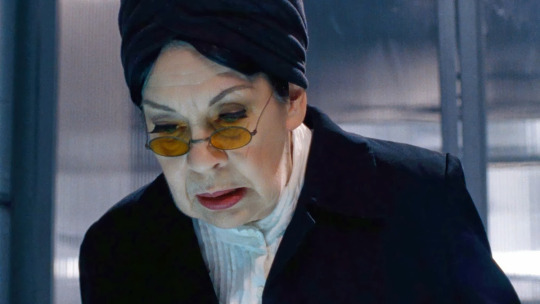
Mademoiselle / Martyrs (2008) — Pascal Laugier
D: Pascal Laugier nos regala con “Martyrs” una obra tan durísima de ver como de digerir. “Martyrs” no es recomendable para estómagos sensibles y aun así, la reflexión que ofrece una vez terminada, es una gran recompensa para quien haya finalizado el viaje. Una obra más de las numerosas películas gore que nos llegan desde Francia, y es más complejo hablar de un villano único en sí mismo y difícil hacerlo sin destripar su argumento. Digamos que en “Martyrs” el villano es el ser humano como tal y las cosas que es capaz de hacer con el afán de obtener respuestas a preguntas que quizás no estemos preparados para entender. Un deseo que, en determinados estratos sociales, puede llevar a estas mentes curiosas a las acciones más perversas. Como digo, difícil hablar del mal en una sola persona, pero digamos que hay una mujer, llamada Mademoiselle, cabecilla de un grupo de degenerados adinerados que claramente sienten que el fin justifica los medios. Un final que nos deja atónitos y reemplaza la dureza de sus imágenes con profundidad de pensamiento.
Pascal Laugier delivers with “Martyrs” both a really hard to watch and digest film. Martyrs is not for sensitive stomachs and yet, the deep reflection that offers once finished, is a big reward for whoever dared to stay until the end. One more gore film coming from France and really complex to talk here about a single villain and even more difficult to do it without spoilers. Let’s say in “Martyrs” the villain is humankind itself and the things is capable of doing to obtain answers to questions that we may not be able to understand. A desire that can lead these curious minds to the darkest behaviors, especially in some social classes. As I said, really difficult to talk about a single figure but let´s say there´s a woman called Mademoiselle leader from a degenerate, rich group of people that clearly thinks that an end justifies any means.
—

Darth Maul / Star Wars. Episode I: The Phantom Menace (1995) — George Lucas
Adrián: Sin duda uno de los villanos a los que más cariño tengo. Con 7 años descubrí el universo Star Wars viviendo en pantalla grande la aparición de los míticos títulos amarillos. En “The Phantom Menace” Darth Maul aparece pocos minutos pero su impacto es absoluto, sin apenas diálogo le vemos como aprendiz de Darth Sidious y brazo ejecutor de su plan maestro: dar caza a Anakin Skywalker mientras aún es niño. Siempre guardaré en mi memoria la brillate batalla contra Qui-Gon Jinn y Obi-Wan Kenobi, probablemente la mejor coreografiada de todas las que hemos visto en las películas y determinante en el desarrollo de toda la saga. Un auténtico Lord tenebroso.
One of the villains I love the most, no doubt. Being 7 years old I discovered the Star Wars universe watching the mythical yellow titles appear on a big screen. In "The Phantom Menace" Darth Maul appears a few minutes but his impact is absolute, with little dialogue we can see him as Darth Sidious’ apprentice and executor of his master plan: to hunt down Anakin Skywalker while he’s still a child. I will always keep in my memory the brilliant battle against Qui-Gon Jinn and Obi-Wan Kenobi, probably the best choreography of all that we have seen in the movies and decisive in the development of the entire saga. A truly dark lord.
+ Puedes enterarte más sobre la historia de este villano en el post especial sobre Darth Maul.
+ Find out more about this villain in our Darth Maul’s special post.
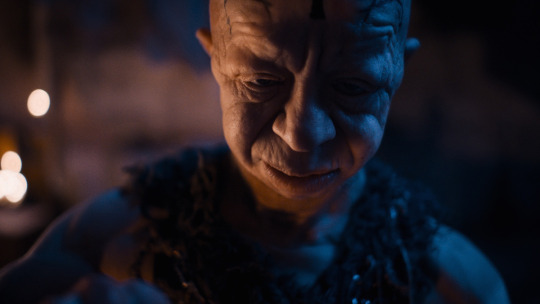
Baba / Baskin (2015) — Can Evrenol
A: Bada se hace un hueco en esta lista por lo bizarro, lo sádico y lo satánico. Su presencia en “Baskin” es exponencial, presente de forma invisible como mano controladora hasta concluir en un ritual de lo más turbio, donde se revela su forma física y ejecuta el sacrifio al que los personajes de la película están sentenciados. Todo posible gracias a la interpretación de Mehmet Cerrahoglu, quien ofrece sus característico físico y sus dotes de interpretación para retratar de forma muy efectiva a este villano.
Bada has a place in this list for the bizarrely, the sadisticly and the satanicly. His presence in “Baskin” is exponential, invisibly present as a controlling hand until concluding in the most murky ritual, where his physical form is revealed and he executes the sacrifice to which the characters of the movie are sentenced. All possible thanks to the Mehmet Cerrahoglu’s acting, who offers his characteristic physique and his performance skills to portray this villain brilliantly.

Puppet Master / Ghost in the Shell (1995) — Mamoru Oshii
A: Podría decirse que Puppet Master no es un villano típico. La idea de la inteligencia artificial revelándose contra la humanidad es algo recurrente en los últimos años y ha sido plasmada en muchas otras películas, como “The Terminator” (1984) o “The Matrix” (1999). Lo interesante de Puppet Master es su enfoque filosófico, el uso de su intelecto como arma implacable. En sus propias palabras: bajo el nombre clave “Project 2501″, es una entidad viva y pensante creada en el mar de la información. El mero hecho de su existencia es alarmante pero la profundidad de su razonamiento lo convierte en un enemigo trascendental.
I may say that Puppet Master is not a typical villain. The idea of artificial intelligence revealing itself against humanity has been a recurring theme in recent years and has been captured in many other films, such as "The Terminator" (1984) or "The Matrix" (1999). The interesting thing about Puppet Master is his philosophical approach, the use of his intellect as a relentless weapon. In his own words: under the code name "Project 2501", he is a living, thinking entity created in the sea of information. The mere fact of his existence is alarming, but the depth of his reasoning makes him a transcendental enemy.
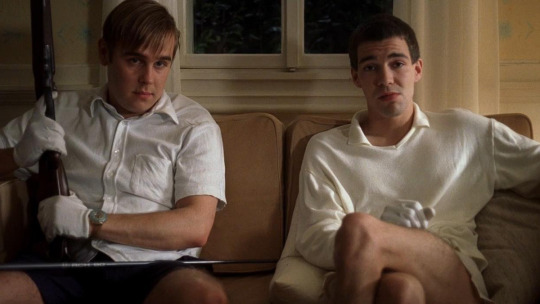
Paul & Peter / Funny Games (1997) — Michael Haneke
A: Paul y Peter son un caso especial en el mundo de los villanos. En el guión de Haneke se nos presenta a una pareja de despiadados adolescentes, con unas formas que chirrían por atentar contra lo que consideramos correcto. Y esque bajo su apariencia pura, elegante y educada se esconden unas mentes perversas. Unos chicos que quieren jugar a toda costa, la vida es el tablero y la inocencia sus piezas.
Paul and Peter are a special case in the villain world. In Haneke's script, we are introduced to a couple of ruthless teenagers, whose manners go against what we consider correct. Under his pure, elegant and polite appearance there are hidden evil minds. A couple of boys who want to play at all costs, life is the board and innocence its pieces.
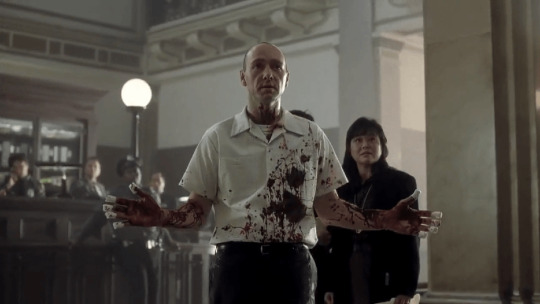
John Doe / Seven (1995) — David Fincher
A: Y cómo no hablar de John Doe. Un villano de libro: metódico, brillante y deliberadamente maligno. La sinfonía que este hombre orquesta en la película de Fincher es digna de estudio, es digna de clasificarse como obra de arte macabra. El nivel de sacrificio y dedicación por vivir y ver su obra concluir es escalofriante. Otro nivel de psicoticismo. Un personaje que desde la sombra hace de “Seven” una obra maestra del thriller policíaco.
And how not to talk about John Doe. A villain by the book: methodical, brilliant, and deliberately evil. The symphony that this man orchestrates in Fincher's film is worth studying, it is even worth classifying as a macabre work of art. The level of sacrifice and dedication for living and seeing his work conclude is spooky. Another level of psychoticism. A character that from the shadow makes "Seven" a masterpiece of police thrillers.
0 notes
Text
THE END OF THE WORLD — List
En estos tiempos de incertidumbre queremos recordar películas que nos hicieron reflexionar sobre el fin del mundo, desde un punto de vista global y personal.
In this uncertain times we want to remember those movies that made us think about the end of the world, from a global and personal point of view.

Melancholia (2011) — Lars Von Trier
Diego: Lars Von Trier es incontestablemente único en su forma y contenido. En mi opinión, él es su proprio amigo y enemigo, creador de maravillas al igual que de desastres. Uno no puede existir sin el otro ya que sus caprichos son los ingredientes de sus maravillas que, cuando bien equilibrados, dan lugar a obras como “Melancholia”. Este film sigue teniendo su sello, sus manías y sus aires de grandilocuencia pero tan bien hecho, tan poderoso visualmente que no queda otra que rendirse.
En “Melancholia” tenemos dos capítulos muy bien diferenciados. En el primero, Justine y su prometido Michael, celebran su boda con una suntuosa fiesta en casa de su hermana y su cuñado. Mientras tanto, el planeta Melancolía se dirige hacia la Tierra en forma de estrella roja en el firmamento. El segundo, la bizarra celebración termina de una forma aún más extraña y nos centramos ahora en los efectos que el acercamiento del planeta tiene en la familia. La apocalíptica sinopsis sirve al director danés como excusa para mostrarnos un complejo drama familiar con toques fantásticos. Un estudio profundo sobre la depresión, un drama pesado durante todo su metraje y una belleza formal hipnótica presente durante toda la historia recompensará al espectador que se entregue totalmente al ejercicio. Sin ser perfecta, trasmite correctamente diversas emociones e ideas muy interesantes. En momentos sentimos “Melancholia” acercándose, suponiendo el fin de todo y sentimos sus efectos mágicos sobre nuestra psyche, quebrándola por momentos y transformando a los locos en cuerdos y a los cuerdos en locos.
En caso de no caer en el conjuro de Von Trier, cualquiera debería sentirse en parte recompensado por uno de los finales mas bellos y aterradores de la historia del cine.
Lars Von Trier is undoubtedly unique in its form and content. In my opinion, He’s his own friend and enemy, creating both amazing pieces and disasters. One wouldn’t exist without the other and there are his whims the ingredients of his masterpieces that, when well balanced, creates films like Melancholia. This movie still has Von Trier’s stamp, his obsessions and his grandiloquence and still so well done, so visually powerful that will make you surrender to it.
In Melancholia we have 2 different chapters. In the first one, Justine and her fiancée Michael are celebrating their marriage at a sumptuous party in the home of her sister and brother-in-law. Meanwhile, the planet, Melancholia, is heading towards Earth being seemed as a red star up in the firmament. The second one, the bizarre celebration ends in an even more strange way and the film focuses now in the effects the approaching of the planet has in the family. The apocaliptyc plot serves Von Trier as an excuse to show us a complex familiar drama with touches of fantasy. A deep study about depression, a heavy drama along the way and a formal and hypnotic beauty is present during the story which will reward the viewer who was able to surrender to wthat´s shown in the screen.
Far from being perfect, it delivers really interesting emotions and ideas. There´s moments where we feel ourselves the planet ¨Melancholia¨ getting closer, meaning the end of everything and we feel its magic effects over our mind, breaking it at times and transforming the mad into sane and the sane into mad. If you don´t fall under Von Trier´s spell, everyone should feel partially rewarded by one of the most beautiful yet frightening movie end in film history.

Perfect Sense (2011) — David Mackenzie
D: David Mackenzie estrenó la que para mí es su mejor película en 2011, pasando por Sundance y alimentando uno de los numerosos misterios del cine, el de cómo una obra tan maravillosa ha pasado tan desapercibida, no solo en ese año, sino también en los venideros. “Perfect Sense” no es una película sobre el fin del mundo per se, pero merece un puesto en esta categoría igualmente. En ella, el chef Michael y la investigadora Susan se conocen y se enamoran mientras se extiende mundialmente una grave epidemia que priva a la gente de sus percepciones sensoriales. Es aquí donde el film adquiere su fuerza y originalidad: en el intervalo continuo entre la maravillosa historia de amor y las consecuencias de una pandemia que elimina uno a uno los sentidos, con un formato cuasi documental.
Tanto Ewan McGregor como Eva Green llenan a sus personajes de gran humanidad y vulnerabilidad y, en conjunto con la excelente realización de Mackenzie y la simple, íntima y efectiva fotografía de Giles Nuttgens, la historia de amor parece propia, como si fuésemos testigos a través de una puerta entreabierta del enamoramiento de sus dos protagonistas durante la pandemia, que consecuentemente les une más. Mención especial merece el grandísimo Max Richter que musicaliza esta pandemia y sus horrores, así como los paseos de los enamorados o sus emociones de forma magistral otorgando a la película de alma.
Nunca olvidaré a Michael y Susan bailando y jugando a “Make Me Special”, acariciándose asustados o la adaptación de los personajes al nuevo mundo que se mostraba ante ellos, acercándose a los altavoces en un club para sentir la vibración o alimentándose a través del oído o el tacto. Nunca olvidaré ese último abrazo con fundido a negro en la visión y en la pantalla...
David Mackenzie released what for me is his best film back in 2011, after being released in “Sundance”, feeding one of the numerous movie mysteries, when such an awesome film goes unnoticed, not only in that year but in the ones to follow. “Perfect Sense” is not a classic “End of the world” kind of movie, but it’s worthed a place in this list. In the film, Chef Michael and epidemologist Susan meet and fall in love while a serious global epidemy unfolds getting rid of everyone’s senses, one by one.
Both Ewan MacGregor and Eva Green give humanity and vulnerability to their characters and joined by the excellent direction from Mackenzie and the simple yet intimate and effective cinematography from Giles Nuttgens, the love story seems ours, as we would be witnessing through a little hole the main character’s falling in love while the pandemic is taking place, which brings them even closer. Special mention to Max Richter who signs the soundtrack and gives music to the pandemic and its horrors as well as the walks from the lovers or their emotions giving the movie its soul.
I’ll never forget Michael and Susan dancing while playing “Make Me Special”, caressing each others face in fear or everyon’s adaptation to the new world, going closer to the big speakers in a club to feel its vibration or feeding themselves throguh their hearing or touch. I’ll never forget that last hug fading to black, in their eyes and in the screen...

I am legend (2007) — Francis Lawrence
D: “Soy leyenda” probablemente sea el único blockbuster de libro en esta lista. No obstante y por diversos motivos, siempre guardo gran recuerdo de ella y de las emociones e ideas que me transmitió en sus visionados. Todo el mundo la denostó comparándola siempre a una de sus predecesoras adaptaciones al cine de la novela de 1954 de Richard Matheson, “El último hombre... vivo”. En este caso, Poca gente se vio conquistada por la interpretación de Will Smith del científico Robert Neville debido a la larga sombra de su predecesor Charlton Heston y por la común dificultad de los cinéfilos para enfrentarse a la obra con mente abierta y ausencia de prejuicios.
Will Smith aquí nos muestra su arsenal interpretativo, con la única compañía de su perro siendo el último hombre vivo que hay sobre la Tierra acompañado de otros seres, convertidos en una suerte de vampiros, infectados a causa de un virus creado por el hombre (cualquier comparación con la actualidad es pura coincidencia).
Ideas muy interesantes y muy bien representadas como la soledad, pandemias, mucha intensidad, humor, algo de terror, drama e incluso religión (en su odiado tramo final) crean una aventura ultra entretenida con dos momentos para el recuerdo: Will Smith perdiendo la cordura gritando a un maniquí o abrazando a su perro agónico... ¡De piel de gallina!
“I am Legend” is probably the only blockbuster from the list. Nevertheless and due to various reasons, I’ve always kept good memories from this film and from the emotions and ideas I got from it. Everybody back then compared it to one of its previous adaptations from 1954 Richard Matheson’s novel, “The Omega Man”. Not many people enjoyed Will Smith’s portrait from scientists Robet Neville due to Charlton Heston’s shadow and to the common lack of open and non-judgmental mind movie lovers tend to have.
Will Smith shows off here all his acting skills with his character’s dog as only company being the last living man in the earth, joined by some vampire like beings, infected by a man made virus (any similarity to the actual times is pure coincidence).
Really interesting and well portrayed ideas such as loneliness, pandemics, lot of intensity, humour, a bit of horror, drama and even religion (during its disliked last bits) delivers a thrilling adventure with 2 particular moments to remember: Will Smith loosing his shit screaming to a manikin or huging his dying dog... Goosebumps!
—

Sunshine (2007) — Danny Boyle
Adrián: Creo que “Sunshine” se merece con creces estar en cualquier lista sobre el fin del mundo. Además también podría hacerlo con gran nota en el sci-fi, siendo una aventura espacial de calibre visual y argumental, e incluso el slasher, con una terrorífica vertiente final que pone los pelos de punta y nos agarra al asiento. El tándem Danny Boyle y Alex Garland nunca defrauda cuando queremos enfrentarnos a una película politemática, que nos hierva la sangre y nos deje pensando durante un buen rato...
Pero en este caso hablamos del fin del mundo, y en el fin del mundo me centro: en esta película un grupo de mujeres y hombres se encargarán de transportar una carga explosiva a bordo de la nave espacial Ícarus II. Su objetivo es completar la misión en la que su predecesora fracasó y reactivar el Sol antes de que se apague, poniendo fin a la vida en la Tierra.
Me encanta que el motivo del fin sea la muerte del Sol (suceso objetivamente real) y la mitología utilizada al respecto, desde el propio nombre de la nave hasta el papel que los personajes juegan. Además favorece esta mezcla de géneros que la película se centre en la misión y no en las consecuencias que esto tiene en nuestro planeta. De alguna forma vemos toda una sociedad resumida en la tripulación de la nave, diferentes formas de enfrentarse a un final inminente contando con el peso añadido de la responsabilidad: salvar a la humanidad con sólo una bala en el cargador.
Aunque no sea científicamente certera en algunos casos, es un must para cualquier amante del sci-fi. Y más importante aún, es una cinta muy recomendable para cualquiera que disfrute de un espectáculo audiovisual espacial y quiera romperse un poco el coco.
I think "Sunshine" truly deserves to be in any “end of the world” list. It could also make it in science fiction, being visually and plotwise a high quality space adventure, or even in slasher, with a terrifying final act that makes your hair stand on end and grabs you to the seat. The Danny Boyle and Alex Garland tandem never disappoints when we want to face a polythematic movie, that will make our blood boil and will let us thinking for some time...
But in this case we are talking about the end of the world, and I’ll focus on that: in this film a group of women and men will be in charge of transporting an explosive cargo aboard the spacecraft named Icarus II. Its objective is to complete the mission in which its predecessors failed and reactivate the Sun before it goes out, ending all life on Earth.
I find really interesting the death of the Sun as the reason to the end (objectively something that will happen) and the mythology used around it, from the name of the ship to the role the characters play. Furthermore, the film focusing on the mission and not on the consequences this has on our planet favors this mix of genres. Somehow we see a whole society portrayed in the ship's crew, different ways of facing an imminent end topped up with the responsibility’s weight: only one chance to save humanity.
Although it is not scientifically accurate in some cases, it is a must for any sci-fi lover. I strongly recommend this film to anyone who enjoys a spacial audiovisual show and wants to bash their head up a bit.
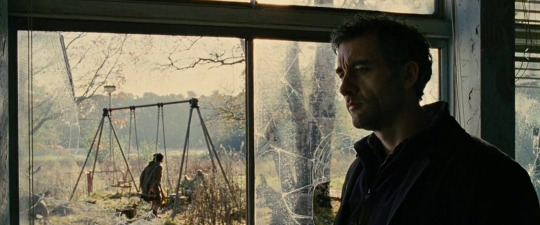
Children of Men (2006) — Alfonso Cuarón
A: Desde un punto de vista distópico, en “Children of men” nos enfrentamos a la decadencia del ser humano como especie. Se nos presenta una sociedad totalmente jerarquizada y al borde de la desesperación. Vemos cómo la conciencia del fin inminente saca el lado más oscuro de la civilización y la falta de esperanza se traduce en represión y abuso.
Esta película muestra la visión pesimista pero real de lo que podría suceder llegado el caso, y es que el argumento gira en torno a la imposibilidad de procrear, el desconocimiento del motivo y la falta de una solución. Seguimos los pasos de Theo (brillantemente interpretado por Clive Owen), un activista renegado y desmotivado al que se le confía la vida de la mujer que podría salvar la humanidad. A través del viaje de estos dos personajes vamos presenciando los altibajos de la sociedad, en lo que ésta podría convertirse. Su camino es crudo pero aderezado con justas dosis de esperanza y humanidad, hasta llegar a un final agridulce que nos deja con el corazón en un puño.
En el apartado técnico Alfonso Cuarón hace alarde de su calidad como director, es una auténtica obra maestra con una dirección de cámara, fotografía y escenografía impecables. En esta cinta se recogen planos secuencia que permanecerán en la memoria para siempre y creo que sólo por este despliegue de calidad se ha merecido un hueco entre las mejores películas de la historia.
Un relato impecable y una puesta en escena sobrecogedora, “Children of men” es cruda pero bella a rabiar.
From a dystopian point of view, in "Children of Men" we face the decline of the human being as a species. We are presented with a totally hierarchical society on the brink of despair. We see how the acceptance of the imminent end brings out the darkest side of civilization and the lack of hope translates into repression and abuse.
This film shows us the pessimistic yet real vision of what could happen given the case, the plot revolves around the impossibility of procreating and the lack of reason and solution. We follow Theo’s journey (brilliantly played by Clive Owen), a renegade and unmotivated activist who’s entrusted with the life of the woman who could save humanity. Throughout the journey of these two characters we witness the ups and downs of society, as it would be. Their path is raw but seasoned with doses of hope and humanity, until reaching a bittersweet ending that leaves us with a heavy heart.
Technically speaking, Alfonso Cuarón flaunts his quality as director, it is a true masterpiece with an impeccable camera, cinematography and scenography direction. In this film there’re sequence shots that will remain in the memory forever and I think that only for this quality exhibition has earned a place among the best films in history.
A faultless storyline and staging, "Children of Men" is crude yet extremely beautiful.

Take Shelter (2011) — Jeff Nichols
A: Incursión en la psique humana de la mano de Jeff Nichols, quien escribe y dirige esta historia de manera magistral. Centrándose en los problemas mentales a los que se enfrenta Curtis, padre y marido, esta película nos muestra a una modesta familia de una forma muy íntima. Con ayuda de una fotografía apagada y una gran banda sonora construye pausada y meticulosamente angustia de principio a fin. El protagonista cuestiona sus creencias al tener sueños apocalípticos de lo más vívido y esto revuelve su pasado, presente y futuro. Veo un estudio social y personal sobre la esquizofrenia, una muestra de cómo puede afectar al que la padece y a las personas a su alrededor.
Sin ahondar demasiado en la trama aconsejo entrar virgen a esta película, tiene un efecto moralizador increíble haciendo que te cuestiones los límites de la realidad, su subjetividad y la relación que nuestros miedos tienen con cualquier aspecto de nuestras vidas. Todo esto en un thriller con tintes de drama psicológico y momentos de absoluto terror.
Incursion into the human psyche by Jeff Nichols, who masterfully writes and directs this story. Focusing on the mental problems faced by Curtis, father and husband, this film shows a modest family in a very intimate way. Supported by a dull cinematography and a great soundtrack, he slowly and meticulously builds anguish from beginning to end. The protagonist questions his beliefs by having the most vivid apocalyptic dreams and this stirs up his past, present and future. I see a social and personal study on schizophrenia, a view on how it can affect those who suffer from it and the people around them.
Without getting too deep into the plot, I recommend facing this film knowing as less as possible, it has an incredible moralizing effect wich makes you wonder the limits of reality, its subjectivity and the relationship that our fears have with any aspect of our lives. All of this in a thriller with hints of psychological drama and extrimely terrifying moments.
—

This is the end (2013) — Seth Rogen & Evan Goldberg
D/A: Para concluir esta lista y después de una selección de películas dramáticas queremos ofrecer una visión cómica y entretenida sobre el fin del mundo: “This is the end”.
No mucho que aprender, no mucho que pensar. Seth Rogen y Evan Goldberg se juntan para crear una parodia de sí mismos y sus colegas de la industria, que parece sacada de una larga sesión de marihuana. En la película son testigos de cómo el mundo llega a su fin forzándoles a trabajar juntos para sobrevivirlo, para ello tendrán que enfrentarse a las más bizarras e hilarantes situaciones. La película destaca en originalidad cuando vemos a sus personajes interpretarse a sí mismos, siendo el punto de partida la fiesta de cumpleaños de James Franco, en la que asistimos a los entresijos de las celebrities que allí se reunen: celos, envidias, rencores... Cualquier parecido con la realidad podría ser mera coincidencia.
James Franco ridiculizado por su faceta hipster/snob, Emma Watson sacando su cara más egoísta, Michael Cera acosando a Rihana o Jonah Hill siendo sodomizado por una criatura bíblica, son solo una muestra de esta loca y divertida caricatura. Perfecta para ver con tu grupo de colgados.
To finalise this list and after a selection of rather dramatic films, we wanted to offer a funny and entertaining take of this apocalyptic topic: “This is the end”.
Not much to learn here, not much to think about. Seth Rogen and Evan Goldberg teamed up after what it seemed to be a weed smoking session, to make fun of themselves and their closest friends in the industry. In the movie, they witness the world coming to an end, forcing them to get together in order to survive. The film remains particularly original when we witness the characters playing themselves, being the starting point James Franco’s birthday party, where we see the “ins and outs” from the celebrities who gathered in there, their jealousy, envies… Any resemblance with reality could be mere coincidence.
James Franco being ridiculed by his artistic/hipster side, Emma Watson showing her most selfish side, Michael Cera harassing Rihana or Jonah Hill being sodomized by a biblical creature are only a summary from this crazy and funny nonsense. Perfect to watch with your beloved stoneheads.
0 notes
Text
THE TREE OF LIFE — Q&A
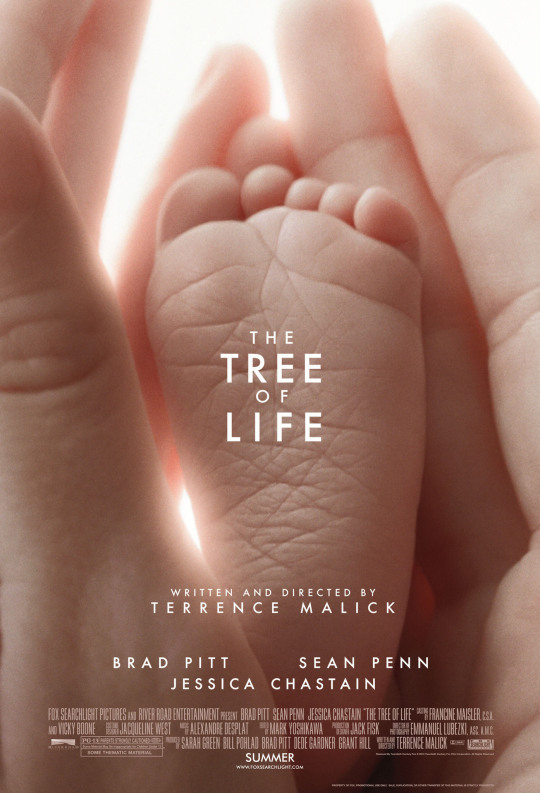
Diego: ¿Por qué vamos a hablar de esta película? / Why are we going to talk about this film?
Adrián: "El árbol de la vida” supuso un despertar en nuestro interior, cinematográfica y mentalmente hablando. Esta película nos ha acompañado desde entonces y guardamos un especial cariño hacia ella por ir en sintonía con nuestras vivencias familiares y nuestras inquietudes personales. Da título a este blog/experimento y no podríamos empezarlo de mejor forma que haciéndole mención.
"The tree of life" was an awakening within us, cinematically and mentally speaking. This film has been with us since then and we have a special affection for it for being in tune with our family experiences and our personal concerns. It named this blog/experiment and we couldn't think of a better start than giving credit to it.
—
D: ¿Si pudieses elegir una escena que representa el espíritu de la película, cuál sería? / If you could pick a scene that holds the film’s spirit, which one would be?
A: Después de meditarlo creo que elegiría la secuencia final en la que Jack se reencuentra con los personajes de su vida en una playa de marea baja. Creo que lo que sucede en este entorno tranquilo a la vez que catártico recoge gran parte del significado que me atrae de la película: el amor como motor. Tras vivir una vida de resentimiento hacia su padre, desapego hacia su madre y pena por la pérdida de su hermano, Jack se encuentra con todos ellos para descubrir que el amor subyacía y persistía. Siendo él muy pequeño su madre apuntaba al cielo y decía: “That's where God lives”. A lo largo de su infancia ella trata de enseñarle que Dios es amor y éste se encuentra en todas partes. Siempre podremos redimirnos cuando nos encontremos con Él en su casa, pero ¿no es mucho más bello vivir con esa enseñanza que esperar a aprenderla cuando lleguemos a la playa de marea baja?
Thinking about it I’d choose the final sequence when Jack meets the characters of his life on a low tide beach. I think what happens in this calm and cathartic environment picks up much of the meaning that attracts me from the film: love as a motor. After living a life of resentment towards his father, detachment from his mother and grief for his brother’s loss, Jack meets all of them to discover that love underlayed and persisted. When he was very young, his mother pointed to the sky and said: "That's where God lives." Throughout his childhood she tries to teach him that God is love and that it’s found everywhere. We can always redeem ourselves when we meet Him at his home, but isn't it much more beautiful to live with that teaching than waiting to learn it when we reach the low tide beach?
—
D: ¿Qué nos quiere transmitir Malick a traves de su película? / What is Malick trying to tell us throughout his film?
A: Es difícil concretar la idea a transmitir detrás de esta película. A Malick le sirvió como ejercicio autobiográfico y pienso que gran parte de sus inquietudes personales están volcadas en la cinta. “The nuns taught us there were two ways through life - the way of nature and the way of grace. You have to choose which one you'll follow.”. Como dije anteriormente, el amor como motor es el significado que más me atrae de esta película y creo que Malick quiere hacernos conscientes de que sea cual sea nuestro camino debemos recorrerlo con amor. En la película nos muestra ambos modos de ver la vida: el científico y religioso, uno basado en la naturaleza y otro en la fe. Estos dos caminos confluyen en la figura de la madre, que nos enseña el lenguaje a hablar sea cual sea nuestra decisión.
It’s hard to find the general idea behind this film. It served Malick as an autobiographical exercise, and I think the movie has much of his personal concerns. “The nuns taught us there were two ways through life - the way of nature and the way of grace. You have to choose which one you'll follow.”. As I said earlier, love as a motor is the meaning that attracts me the most and I think Malick wants to make us aware of that. Whatever our path is, we must follow it with love. He shows us both ways of seeing life: the scientific and the religious, one based on nature and the other on faith. These two paths converge in the figure of the mother, who teaches us the language to speak whatever our decission may be.
—
D: ¿Qué otra película vibra en la misma frecuencia que “El árbol de la vida”? / What other movie vibrates in the same frequency as “The tree of life”?
A: Esta película es única en forma y contenido. Es un director cuyo sello es la propia frecuencia en la que vibran sus películas. Sin pensarlo demasiado la primera que se me viene a la cabeza es “The fountain” de Darren Aronofsky, por ofrecernos esa misma dualidad en su historia: el camino de la ciencia y la fe, con el amor como motor. Pero quiero también hacer mención a “Paris, Texas” de Wim Wenders, una película con una gran similitud argumental, guardando las distancias. Una road-movie cuyo viaje es una introspección hacia la vida olvidada del protagonista, llena de dramatismo pero también esperanza.
This movie is unique in its form and content. Malick is a director whose hallmark is the frequency at which his films vibrate. Without giving too much thought, the first one that comes to my mind is “The fountain” by Darren Aronofsky, offering us that same duality in his story: the path of science and faith, with love as a motor. But I also want to mention Wim Wenders' “Paris, Texas”, a film with great similarity storylinewise, keeping its distance. A road-movie whose journey is an introspection towards the protagonist's forgotten life, full of drama but also hope.
—
D: ¿Qué pieza de la banda sonora es para ti "El árbol de la vida"? / What piece from the soundtrack is "The tree of life" in your opinion?
A: Sin lugar a dudas, la pieza que me eriza la piel cada vez que la escucho, la que inicia el capítulo sobre la infancia y el aprendizaje: la familia. Hablo de “Má Vlast: Vltava”. Escuchándola al completo me doy cuenta de que guarda una especial similitud con la historia de la película y parece que funciona como una transcripción musical de la misma.
Without any doubt, the piece that gives me goosebumps every time I listen to it, the one that sets the beginning of the family chapter, childhood and learning. I talk about “Má Vlast: Vltava”. Listening to it in its entirety I realize that it bears a special similarity to the story of the film and it seems to work as a musical transcription of it.
youtube
Adrián: ¿Cuál sería tu resumen de la película para alguien que no la ha visto? / What would be your sinopsis of the film for someone who hasn’t watched it?
Diego: Obviamente es una película bastante difícil de resumir y sin duda me he visto en la situación de tener- o querer- explicarle a alguien interesado lo que se puede encontrar al enfrentarse a ¨El árbol de la vida¨.
Siempre he sentido que al simplificarla en algo muy breve traiciono a la obra en sí. De modo que, al ser preguntado por ella, suelo describirla como una obra muy filosófica, sin una estructura a la que el cine nos tiene acostumbrados, con pocos diálogos y, como ves, acabo avisando más que describiendo. Esto es algo a lo que me he enfrentado numerosas veces ya que si hablo de lo que realmente venero en el cine, acabaría mencionando a Malick y su obra. Al ser ésta bastante desconocida por el público general, la pregunta sobre su trama suele venir a continuación:
Si no tuviese que avisar y pudiese describir, hablaría de una pieza audiovisual de alto calado e ideas filosóficas, que abarca todo y genera una perspectiva profunda y temporal entre la inmensidad del universo y su creación con todos sus seres a la intimidad de los sentimientos y emociones de una familia que lidia con la pérdida y la muerte de uno de sus miembros. La niñez, la infancia, el descubrimiento de diversas emociones por primera vez. Diversos puntos de vista y momentos temporales en las vidas de esta familia que, junto a los momentos más impersonales, generan un mosaico perfecto sobre la vida y nuestra existencia.
Honestly, this is a movie that´s pretty difficult to summarize anyway and surely, I´ve seen myself in the situation of having or wanting to explain it to someone who´s interested to give an idea of what anyone will find when facing “The tree of life”.
I´ve always somehow felt that when trying to simplify the plot of the movie, I betray the film itself, so, when being asked about it, I tend to describe it as a deep philosophical movie, with a different structure mainstream films got us used to, not many dialogues and as you can see, I end up warning more than describing. I’ve been in this situation numerous times in different movie talks because if I have to talk about what I really love in movies, I would end up talking about Malick and his masterpiece, and being this one pretty unknown for the general public, the question about its plot use to come right after!
If I wouldn’t have to warn anyone and I could really describe it, I would be talking about a movie deeply rooted in phylosofical ideas, which embraces everything and creates a deep and timeless perspective of the infinity of the universe, from its creation with all its beings to the intimicy of the feelings and emotions of a family who deals with the loss and death of one of its members. Different points of view and points of time throughout the family’s life that, together with the most impersonal moments, generates a perfect canvas about life itself and our existence.
—
A: Si tuvieras que elegir un simbolismo/metáfora que destacar sobre los demás, ¿cuál sería? / If you had to choose a symbolism/metaphore to highlight above the rest, wich one would it be?
D: No podría centrarme en una sola escena, secuencia o metáfora, a pesar de encontrar numerosas a lo largo de la película. Quizá es una lectura más personal ya que este film se comunicó poderosa y personalmente con el “yo adolescente” que la disfrutó por primera vez en 2001. Me encontraba en un momento de mi vida en el que íntimamente me preguntaba muchas cosas existencialistas. Quizás la película no me dio las respuestas, pero como amante del cine fue una epifanía encontrar un artista que quizá se hacía las mismas preguntas y sentí que me comunicaba algo conocido de una manera espléndida. Diría que elijo la dicotomía presente en toda la película: la intimidad más absoluta del ser humano, sus emociones, deseos, culpas, rencores; y la infinidad, frialdad del impersonal universo, su naturaleza siempre cambiante a la par que creador absoluto.
I couldn´t focus only in one thing throughout the movie, not a single scene, methafor or sequence. Maybe this is a more personal take as I find it as a priority because this film connected with the ¨adolescent me¨who enjoyed it for the first time back in 2001. I was in a moment in my life when privately I was going through numerous existencialist thoughts. The movie did not answer my questions, however as an already movie lover, it was an ephifany to find an artist who was kind of asking the same questions and I felt it was telling me something known already, but displayed beautifully. I would say I could choose the dichotomy, always present throughout the film between the most absolute intimicy of the human being and it´s emotions, desires, guilts, remorses and the infinity, immensity, distancy of the unknown and always changing universe and its nature, creator of everything.
—
A: ¿Qué significado le encuentras a la secuencia de los dinosaurios? / What’s the meaning you find on the dinosaur‘s scene?
D: Ésta es una escena muy interesante que únicamente revisitando la película pude llegar a comprender realmente, como muchas otras.
Creo que Malick en esta escena nos hace ser testigos de uno de los primeros momentos en que un ser vivo mostró benevolencia o compasión. Vemos a un dinosaurio desvalido en el suelo cuando un depredador aparece y lo inmoviliza. El primero le dirige una mirada de queja y el segundo le responde levantando su pata y alejándose, dejando a su víctima con vida.
Me parece una forma simple e increíblemente profunda de mostrarnos un acto de compasión en una secuencia increíble en la que los dinosaurios aparecen como primera forma de vida compleja.
This is a really interesting scene which only by watching the movie again I could get to understand completely, as many other bits in the movie.
Malick, in this scene, makes us witness the first moment a living thing showed such a complex emotion, like compassion. We see a hurt dinosaur laying in the ground movilized by a carnivour dinosaur. The first one looks scared and the carnivorous stares back lifting up its paw, sparing up its life as it walks away.
I find this a simple yet amazingly deep way to show us an act of compassion in a great sequence with the dinosaurs as the first complex living thing in the whole creation of the universe sequence.
—
A: Como dato: Sean Penn tuvo algún desencuentro con Malick respecto al montaje final, en el cual se le omitió de gran parte del metraje. En otras películas Malick hizo lo mismo con grandes nombres de la interpretación, reduciendo su espacio a minutos (como George Clooney en “The Thin Red Line“). ¿Qué te dice esto sobre el director? / As a fact: Sean Penn had a disagreement with Malick regarding the final cut, in which much of his footage was deleted. In other films Malick did the same with big names in the acting scene, reducing his space to minutes (like George Clooney in "The Thin Red Line"). What does this tell you about the director?
D: Me dice básicamente lo que es. A través de numerosas entrevistas a su equipo, actores y productores, debido a que Malick nunca da la cara en premieres o estrenos, podemos encontrar a un artista puro, extraño en los tiempos que corren. Un artista que ama su arte y que solo lo concibe como creación de su pieza y abstracción de toda la pomposidad y marketing posterior. En esto podemos entender perfectamente que Malick no entiende de caché. No le importa cuán famosos sean sus actores o cuánto tiempo mostrarán su cara en pantalla. Sus actores son meras piezas del puzzle, tan importantes para él como el espacio o la naturaleza que les rodea. Terrence Malick es un maestro antiguo y moderno a la vez, sin inclinación o interés en ninguna estupidez Hollywoodiense y su equipo solo disfrutará de la experiencia si se sumergen en esta frecuencia. Parece que no fue el caso de Mr. Penn.
It basically tells me what it is. Through numerous intervies to Malick´s crew like actores or producers as Malick never shows his face at premieres or releases of his own movies, we can find a pure artist, a strange one for this times. He´s an artist who loves his craft and only understands it as the creation of his piece and total absensce from the flamboyant release and marketing that comes right after. Here, we can understand Malick doesn’t care about any actor’s cache. He doesn´t care how famous his actors are or how long their faces will be shown in camera. His actors are just a piece on his puzzle, as important to him as the space or nature that surrounds them. Terrence Malick is a simultaneous old and modern master and doesn’t have any inclination or interest on any stupid “Hollywood” bullshit and its team will only enjoy the experience if they decide to tune in with his frequency. It seems wasn´t the case with Mr. Penn.
—
A: No puedo evitar concluir preguntándote también, ¿qué pieza de la banda sonora es para ti "El árbol de la vida"? / I can't help but asking you too, what piece of the soundtrack is "The Tree of Life" for you?
D: En este caso y a pesar de que “El árbol de la vida” está llena de temas icónicos que immediatamente al escucharlos me llevan a esta película, me quedaría con el siguiente, y explico por qué. Es el inicio musical de lo que para mí es la más bella de las secuencias de la película: sus protagonistas enamorándose y creando vida.
In this case and although “The tree of life” is full of iconic musical pieces which, when listening to them in any situation would take me immediately to the movie, I would pick the following and let me explain why... It simply colours the beginning of what for me is probably one of the most beautiful scenes from the film. Their main characters falling in love and creating life.
youtube
3 notes
·
View notes

